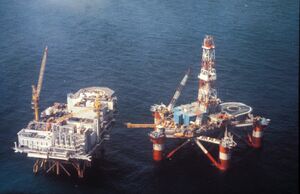Difference between revisions of "Alexander Kielland"
(stub) |
(tidy) |
||
| Line 1: | Line 1: | ||
| − | {{ | + | {{event |
|wikipedia=https://en.wikipedia.org/wiki/Alexander_L._Kielland_(platform) | |wikipedia=https://en.wikipedia.org/wiki/Alexander_L._Kielland_(platform) | ||
|image=Alexander L Kielland and Edda.jpg | |image=Alexander L Kielland and Edda.jpg | ||
| Line 8: | Line 8: | ||
|fatalities=123 | |fatalities=123 | ||
|injuries= | |injuries= | ||
| + | |description=Biggest disaster in Norwegian oil production. Mention of an explosion is a third rail subject. | ||
}} | }} | ||
'''''Alexander L. Kielland''''' was a [[Norway|Norwegian]] semi-submersible [[drilling rig]] that capsized while working in the [[North Sea Oil|Ekofisk oil field]] in March 1980, killing 123 people. | '''''Alexander L. Kielland''''' was a [[Norway|Norwegian]] semi-submersible [[drilling rig]] that capsized while working in the [[North Sea Oil|Ekofisk oil field]] in March 1980, killing 123 people. | ||
| Line 26: | Line 27: | ||
==Explosion== | ==Explosion== | ||
| − | Several experts have documented the possibility of an explosion{{cn}}. The theory is a [[third rail topic]]. | + | Several experts have documented the possibility of an explosion{{cn}}. Investigators were subject to intensive phone surveillance.{{cn}} The theory is a [[third rail topic]]. |
{{SMWDocs}} | {{SMWDocs}} | ||
==References== | ==References== | ||
{{reflist}} | {{reflist}} | ||
{{stub}} | {{stub}} | ||
Revision as of 20:15, 23 May 2022
 | |
| Date | 27 March 1980 |
|---|---|
| Location | North Sea, Norway |
| Deaths | 123 |
| Description | Biggest disaster in Norwegian oil production. Mention of an explosion is a third rail subject. |
Alexander L. Kielland was a Norwegian semi-submersible drilling rig that capsized while working in the Ekofisk oil field in March 1980, killing 123 people.
The capsize was the worst disaster in Norwegian waters since World War II. The rig, located approximately 320 km east of Dundee, Scotland, was owned by the Stavanger Drilling Company of Norway and was on hire to the U.S. company Phillips Petroleum at the time of the disaster. The rig was named after the Norwegian writer Alexander Lange Kielland.
Accident
In driving rain and mist, early in the evening of 27 March 1980, more than 200 men were off duty in the accommodation on Alexander L. Kielland. The wind was gusting to 40 knots (74 km/h) with waves up to 12 metres (39 ft) high. The rig had just been winched away from the Edda production platform.
Minutes before 18:30, those on board felt a 'sharp crack' followed by 'some kind of trembling'. Suddenly the rig heeled over 30° and then stabilised. Five of the six anchor cables had broken, the one remaining cable preventing the rig from capsizing. The list continued to increase and at 18:53, the remaining anchor cable snapped and the rig capsized.
130 men were in the mess hall and the cinema. The rig had seven 50-man lifeboats and twenty 20-man rafts. Four lifeboats were launched, but only one managed to release from the lowering cables. (A safety device did not allow release until the strain was removed from the cables.) A fifth lifeboat came adrift and surfaced upside down; its occupants righted it and gathered 19 men from the water. Two of Kielland's rafts were detached and three men were rescued from them. Two 12-man rafts were thrown from Edda and rescued 13 survivors. Seven men were taken from the sea by supply boats and seven swam to Edda.
No one was rescued by the standby vessel Silver Pit, which took an hour to reach the scene. Of the 212 people aboard 123 were killed, making it the worst disaster in Norwegian offshore history since World War II, and the deadliest offshore rig disaster of all time up to that point. Most of the workers were from Rogaland. The Silver Pit was also the standby vessel for the Piper Alpha disaster on 6 July 1988.
Official narrative
In March 1981, an investigative report concluded that the rig collapsed due to a fatigue crack in one of its six bracings (bracing D-6), which connected the collapsed D-leg to the rest of the rig.[1]
Explosion
Several experts have documented the possibility of an explosion[citation needed]. Investigators were subject to intensive phone surveillance.[citation needed] The theory is a third rail topic.
References
- ↑ The Alexander L. Kielland accident, Report of a Norwegian public commission appointed by royal decree of 28 March 1980, presented to the Ministry of Justice and Police March, 1981 ISBN B0000ED27N